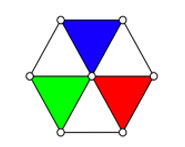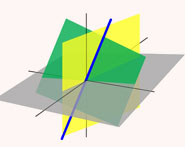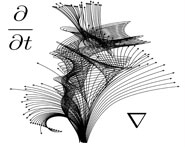


 تاريخ الرياضيات
تاريخ الرياضيات
 الرياضيات في الحضارات المختلفة
الرياضيات في الحضارات المختلفة 
 الرياضيات المتقطعة
الرياضيات المتقطعة
 الجبر
الجبر
 الهندسة
الهندسة 
 المعادلات التفاضلية و التكاملية
المعادلات التفاضلية و التكاملية 
 التحليل
التحليل
 علماء الرياضيات
علماء الرياضيات |
أقرأ أيضاً
التاريخ: 13-7-2018
التاريخ: 18-7-2018
التاريخ: 21-7-2018
التاريخ: 23-7-2018
|
The Euler-Lagrange differential equation is the fundamental equation of calculus of variations. It states that if  is defined by an integral of the form
is defined by an integral of the form
 |
(1) |
where
 |
(2) |
then  has a stationary value if the Euler-Lagrange differential equation
has a stationary value if the Euler-Lagrange differential equation
 |
(3) |
is satisfied.
If time-derivative notation  is replaced instead by space-derivative notation
is replaced instead by space-derivative notation  , the equation becomes
, the equation becomes
 |
(4) |
The Euler-Lagrange differential equation is implemented as EulerEquations[f, u[x], x] in the Wolfram Languagepackage VariationalMethods` .
In many physical problems,  (the partial derivative of
(the partial derivative of  with respect to
with respect to  ) turns out to be 0, in which case a manipulation of the Euler-Lagrange differential equation reduces to the greatly simplified and partially integrated form known as the Beltrami identity,
) turns out to be 0, in which case a manipulation of the Euler-Lagrange differential equation reduces to the greatly simplified and partially integrated form known as the Beltrami identity,
 |
(5) |
For three independent variables (Arfken 1985, pp. 924-944), the equation generalizes to
 |
(6) |
Problems in the calculus of variations often can be solved by solution of the appropriate Euler-Lagrange equation.
To derive the Euler-Lagrange differential equation, examine
 |
 |
 |
(7) |
 |
 |
 |
(8) |
 |
 |
![int[(partialL)/(partialq)deltaq+(partialL)/(partialq^.)(d(deltaq))/(dt)]dt,](http://mathworld.wolfram.com/images/equations/Euler-LagrangeDifferentialEquation/Inline16.gif) |
(9) |
since  . Now, integrate the second term by parts using
. Now, integrate the second term by parts using
 |
 |
 |
(10) |
 |
 |
 |
(11) |
 |
 |
 |
(12) |
so
![int(partialL)/(partialq^.)(d(deltaq))/(dt)dt=int(partialL)/(partialq^.)d(deltaq)=[(partialL)/(partialq^.)deltaq]_(t_1)^(t_2)-int_(t_1)^(t_2)(d/(dt)(partialL)/(partialq^.)dt)deltaq.](http://mathworld.wolfram.com/images/equations/Euler-LagrangeDifferentialEquation/NumberedEquation7.gif) |
(13) |
Combining (◇) and (◇) then gives
![deltaJ=[(partialL)/(partialq^.)deltaq]_(t_1)^(t_2)+int_(t_1)^(t_2)((partialL)/(partialq)-d/(dt)(partialL)/(partialq^.))deltaqdt.](http://mathworld.wolfram.com/images/equations/Euler-LagrangeDifferentialEquation/NumberedEquation8.gif) |
(14) |
But we are varying the path only, not the endpoints, so  and (14) becomes
and (14) becomes
 |
(15) |
We are finding the stationary values such that  . These must vanish for any small change
. These must vanish for any small change  , which gives from (15),
, which gives from (15),
 |
(16) |
This is the Euler-Lagrange differential equation.
The variation in  can also be written in terms of the parameter
can also be written in terms of the parameter  as
as
 |
 |
![int[f(x,y+kappav,y^.+kappav^.)-f(x,y,y^.)]dt](http://mathworld.wolfram.com/images/equations/Euler-LagrangeDifferentialEquation/Inline34.gif) |
(17) |
 |
 |
 |
(18) |
where
 |
 |
 |
(19) |
 |
 |
 |
(20) |
and the first, second, etc., variations are
 |
 |
 |
(21) |
 |
 |
 |
(22) |
 |
 |
 |
(23) |
 |
 |
 |
(24) |
The second variation can be re-expressed using
 |
(25) |
so
![I_2+[v^2lambda]_2^1=int_1^2[v^2(f_(yy)+lambda^.)+2vv^.(f_(yy^.)+lambda)+v^.^2f_(y^.y^.)]dt.](http://mathworld.wolfram.com/images/equations/Euler-LagrangeDifferentialEquation/NumberedEquation12.gif) |
(26) |
But
![[v^2lambda]_2^1=0.](http://mathworld.wolfram.com/images/equations/Euler-LagrangeDifferentialEquation/NumberedEquation13.gif) |
(27) |
Now choose  such that
such that
 |
(28) |
and  such that
such that
 |
(29) |
so that  satisfies
satisfies
 |
(30) |
It then follows that
 |
 |
 |
(31) |
 |
 |
 |
(32 |
REFERENCES:
Arfken, G. Mathematical Methods for Physicists, 3rd ed. Orlando, FL: Academic Press, 1985.
Forsyth, A. R. Calculus of Variations. New York: Dover, pp. 17-20 and 29, 1960.
Goldstein, H. Classical Mechanics, 2nd ed. Reading, MA: Addison-Wesley, p. 44, 1980.
Lanczos, C. The Variational Principles of Mechanics, 4th ed. New York: Dover, pp. 53 and 61, 1986.
Morse, P. M. and Feshbach, H. "The Variational Integral and the Euler Equations." §3.1 in Methods of Theoretical Physics, Part I.New York: McGraw-Hill, pp. 276-280, 1953.



|
|
|
|
منها نحت القوام.. ازدياد إقبال الرجال على عمليات التجميل
|
|
|
|
|
|
|
دراسة: الذكاء الاصطناعي يتفوق على البشر في مراقبة القلب
|
|
|
|
|
|
|
هيئة الصحة والتعليم الطبي في العتبة الحسينية تحقق تقدما بارزا في تدريب الكوادر الطبية في العراق
|
|
|